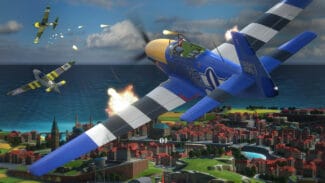With easily 40+ hours of gameplay, tight controls and a deep focus on mission and vehicle variety, Ultrawings 2 is the best flight game you can find in VR. Here’s our full Ultrawings 2 review.
I thought seated VR games were meant to be the comfortable ones. Ultrawings 2 is anything but – my back aches from my hunched pose of zen-like focus, my arms are hard to lift after hours of steering through canyons and across cityscapes, and my teeth are numb from the incessant grinding I subjected them to every time I touched down on yet another tricky landing.
But all of this suffering is self-imposed. I should have taken more regular breaks between the dogfights and airborne obstacle courses. I should have taken the chance stretch my legs, unclench my jaw and let my eyes reacclimatize to reality. Trouble is, Ultrawings 2 is just far, far too tough to put down once it gets its hooks in you.
This is a high-flying success of a VR sequel, preserving everything that worked in the first game but also expanding and — in some areas at least — evolving beyond it. Five all-new aircraft await, each of which provides an enormous number of unique missions split across four main islands. You start out with the game’s most accessible one-man helicopter, earning money to get new vehicles and buy new starting airports which, in turn, unlock swarms of new missions.
Much of what made the first game work is here. Early introductory objectives have you flying through rings either with precision or as quickly as possible, and some of the more playful mission types like shooting down balloons with a pistol in hand return too. This is all still really quite good – the virtual joystick controls remain fantastically responsive — working better than they have any right to — and developer Bit Planet sprinkles in just the right amount of lever-pulling and switch-flicking to make the action authentic without dipping into intimidating Flight Simulator territory.
But these foundations are also put to great use with the game’s new objective types. The big one here is the introduction of more combat elements. Beyond the balloon murder, you can now engage in actual aerial dogfights with AI opponents, or chase down drones in Mario Kart-esque ring races. There was a risk that these would be more of a chore than anything else, as so many flight games fall into the trap of simply making you endlessly rotate around in an exhausting war of attrition.
Here, however, battles are punchy and visceral; it doesn’t take much ammo to bring an enemy down and you’ll more often be locked in a deadly dance of close-quarters twists and turns than you will be searching for a spec in the sky to shoot down from a safe distance. There’s even an impressive — although not exactly necessary — element of persistence, in that enemies you might fail to kill within the time limit on one mission are likely to pop up again to add to the numbers in later operations.
These many mission types, mixed in with the different challenges each new aircraft brings, help keep Ultrawings 2 fresh throughout despite the enormous amount of content on offer. You might think you’ve got the game figured out just as you’ve tamed the swoopy Phoenix, which is fond of swinging out on a wild tangent around every corner, but the next plane, the Stallion throws a whole new type of handling at you. It’s the game’s all-rounder, cutting through the skies at speed but obediently bending to even the slightest touch of the flight stick and allowing for fast races with sharp corners that you’ll still be improving times on hours in.
Then there’s The Comet, a brilliantly zippy little thing propelled by a rocket engine that proves to be a handful as it burns through fuel. You have to use the ignition sparsely and instead work on perfecting exactly how to glide through the air, learning to bank at the right angle and when to deploy flaps to introduce some drag. It adds a meticulous mathematical layer to the gameplay, while the Dragonfly’s feather-touch handling means you’ll spend ages negotiating safe landings on top of skyscrapers. Finally there’s the New Hawk, which handles comparably to the Stallion but opens up a new range of stunt-based missions that pushes both course design and your own dexterity to their limits.
Impressively, unlocking each of these planes, along with the starting airports on each island, took me about 15 hours. And at that point I’d only beaten just of 25% of the entire game (100% requires a Gold rating in every mission). Getting everything in the game will take a significant amount of time to say the least.
Each aircraft also takes yet more time and dedication to truly come to understand and, although you’ll find yourself noticeably improving as the hours fly by, you can’t help but wish Ultrawings 2 was at least a little nicer to you at times. Many of the game’s missions, for example, are book-ended by making you land your vehicle back on the same runway you took off from. In the name of consistency, it makes sense, but there’s nothing more frustrating than finishing a 5-minute mission with a perfect performance, only to come in at ever so slightly the wrong angle on your descent, crash and end up having to replay the whole thing over. Its traumatic enough to recall the days of accidentally flipping a car in the late stages of a Grand Theft Auto mission and having to redo the entire thing.
Most gold rankings, meanwhile, require absolutely flawless performance and, while I welcome a game that properly challenges you, it slows progression considering gold unlocks double the amount of money that bronze and silver earn. Either those medals should earn more or Bit Planet could include a special distinction for perfect runs whilst bringing the requirements for an actual gold down a little.
The game could also be better about keeping you in your craft, rather than having you hop out every mission or after a crash. Failing an event in any way means traveling back to the menu to press the restart button and then putting your helmet back on to load back into the overworld. It’d be helpful to have an instant restart after a crash (you can restart from the pause menu but that requires you to pause before an unexpected incident). Similarly, I’d love to see a Burnout Paradise-style approach to the overworld that lets you change jets and select missions quite literally on the fly.
That might be a technically ambitious ask but, then again, Ultrawings 2 is already a pretty ambitious game, especially on the Quest platform. The game has a really impressive draw distance that lets you take in all four islands from pretty much any area on the map. You can fly over to any of them at any point (though the lengthy gap between each no doubt helps manage any loading).
It’s so big, in fact, that it’d be nice to have a fast travel option to let you go between airports at a moment’s notice. Currently, you have to fly between them which, again, is a thoughtfully authentic touch but also an annoying road bump when you just want to get to your next objectives.
Ultrawings 2 Review – Final Impressions
Ultrawings 2 is the exact kind of VR sequel we’ve been hoping for, building upon the original’s modest beginnings with a massive increase in scope and variety whilst retaining its air-tight controls and level design. Between the five wildly different aircraft and the addition of combat there are plenty of gripping new challenges to pull you in, and the game is always ready to serve up a different kind of thrill. Whether it’s the cinematic satisfaction of blasting past an enemy as they erupt into flames or the laser-like focus needed to land a plane in one piece, Ultrawings 2 either had me grinning like an idiot or on the edge of my seat. It doesn’t make all the right calls, but VR doesn’t get much more rewarding than this superb follow-up.
For more on how we arrived at this rating, read our review guidelines. What did you make of our Ultrawings 2 review? Let us know in the comments below!









